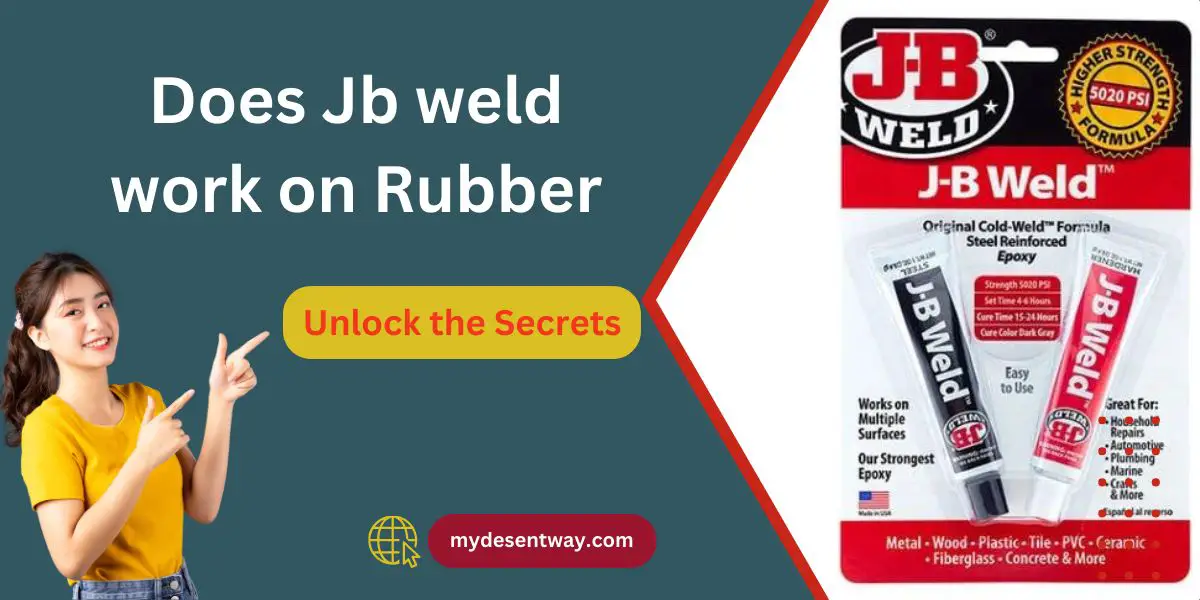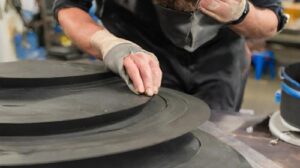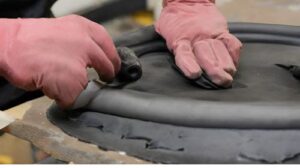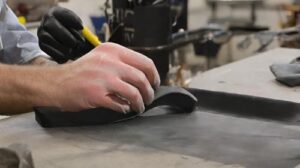Table of Contents
- 1. Discovering How to Fix Rubber
- 2. Does JB Weld Work on Rubber?
- 3. Factors Affecting JB Weld’s Effectiveness on Rubber
- 4. Case Studies and Success Stories
- 5. Alternatives to JB Weld for Rubber Repair
- 6. Tips for Effective Rubber Repair with JB Weld
- 7. Safety Measures and Precautions
- 8. Environmental Impact and Considerations
- Final Thoughts: Does JB Weld Work on Rubber?
- FAQs About JB Weld and Rubber Repair
Welcome to the world of JB Weld – a renowned epoxy adhesive celebrated for its remarkable bonding prowess. Regarding repairs, JB Weld has earned its stripes across various materials, from metals to plastics. However, its compatibility with rubber surfaces beckons exploration.
This article delves into a fundamental question: Does JB Weld mend rubber effectively? Unraveling this mystery holds significance for anyone seeking reliable solutions for rubber repair. Let’s embark on a journey to uncover the potential of JB Weld when it encounters the resilient realm of rubber.
1. Discovering How to Fix Rubber
Properties of Rubber
Rubber is a versatile material used in numerous applications with its remarkable elasticity and flexibility. Its unique properties stem from its molecular structure, offering resilience to stretching, abrasion, and impact. However, despite its durability, rubber is susceptible to wear and tear over time.
Common Issues with Rubber
Several common issues can challenge the longevity of rubber. Cracks, tears, leaks, and degradation due to exposure to environmental factors like sunlight, heat, and chemicals are prevalent concerns. These issues compromise the functionality and aesthetics of rubber components, necessitating timely repair and maintenance.
Understanding the inherent properties of rubber and its challenges provides a foundational understanding essential to exploring the effectiveness of JB Weld as a solution for rubber repair.
2. Does JB Weld Work on Rubber?
Exploring Compatibility
Whether JB Weld effectively works on rubber surfaces sparks curiosity among repair enthusiasts. JB Weld, renowned for its bonding capabilities, presents itself as a potential solution for repairing rubber. However, the real test lies in its compatibility with this resilient material.
Assessing Feasibility
The efficacy of JB Weld on rubber hinges on multiple factors. Surface preparation ensures optimal adhesion between the adhesive and the rubber surface. The type of rubber being repaired, whether natural or synthetic, also influences the bonding strength.
Steps to Using JB Weld on Rubber
Utilizing JB Weld on rubber surfaces involves a systematic approach. Thoroughly cleaning and preparing the surface, applying the adhesive evenly, and allowing sufficient curing time are crucial steps in achieving a durable repair.
Real-world Application
Exploring real-life instances of using JB Weld on rubber surfaces offers valuable insights. Success stories and case studies unveil the practicality of this repair method, shedding light on its effectiveness and durability in real-world scenarios.
Determining Viability
The compatibility of JB Weld with rubber surfaces holds significance for repair enthusiasts seeking a reliable solution. Assessing its effectiveness in bonding with rubber surfaces unveils the potential of JB Weld as a go-to option for rubber repair needs.
3. Factors Affecting JB Weld’s Effectiveness on Rubber
Surface Preparation
A key determinant of JB Weld’s success on rubber lies in surface preparation. Thoroughly cleaning the rubber surface is essential to remove dirt, grease, or contaminants that could hinder proper adhesion. Abrading or roughening the surface slightly can enhance the bond, ensuring a more secure and durable repair.
Type of Rubber
The type of rubber being repaired significantly impacts the bonding strength of JB Weld. Natural rubber, synthetic rubber, or specific rubber compounds may have varying surface properties, affecting how well JB Weld adheres. Understanding the composition of the rubber helps tailor the repair process for optimal results.
Application Method
Applying JB Weld to rubber demands precision and adherence to recommended techniques. Ensuring an even and consistent adhesive application across the repair area is crucial. Following the instructions regarding curing time and environmental conditions also influences the bond’s strength and durability.
Assessing these factors collectively delineates the effectiveness of JB Weld on rubber surfaces. A meticulous approach considering surface preparation, rubber type, and application method maximizes the adhesive’s potential for a successful and long-lasting repair.
4. Case Studies and Success Stories
Real-life Instances of JB Weld on Rubber
Case Study 1: Automotive Rubber Gasket Repair
In an automotive repair scenario, a torn rubber gasket in an engine compartment posed a challenge. After meticulous surface preparation, JB Weld was applied along the tear. The adhesive created a strong bond, exhibiting engine heat and vibrations resilience.
This successful repair showcased JB Weld’s suitability for automotive rubber components, ensuring reliable functionality despite the demanding environment.
Case Study 2: Household Rubber Item Repair
Another instance involved a household rubberized tool handle showing signs of wear. Surface cleaning and precise application of JB Weld effectively reinforced the handle, restoring its functionality. The repair extended the tool’s lifespan and demonstrated JB Weld’s adaptability in addressing common household rubber-related issues.
Success Story: Rubber Seal Repair
A success story revolved around repairing a rubber seal in a plumbing fixture. Adhering to JB Weld’s application guidelines effectively reinforced the seal, preventing leaks and restoring the fixture’s functionality. This success highlighted JB Weld’s reliability in addressing intricate rubber sealing mechanisms.
Outcomes and Durability
The outcomes from these real-life applications showcased the durability and practicality of using JB Weld on diverse rubber surfaces. These success stories substantiated JB Weld’s potential as a dependable solution for repairing rubber. The repairs demonstrated resilience against environmental factors, usage stress, and specific application demands, emphasizing the adhesive’s ability to withstand varied conditions while maintaining structural integrity.
5. Alternatives to JB Weld for Rubber Repair
Diverse Products for Rubber Repair
While JB Weld is celebrated for its adhesive prowess, exploring alternative products for rubber repair provides a comprehensive perspective. Various options exist, each with unique features and applications, catering to different preferences and requirements.
Alternative 1: Rubber Cement
Rubber cement is a traditional adhesive specifically designed for rubber. It offers flexibility and is ideal for repairing minor tears and attaching rubber components. However, its bonding strength may vary and might not be suitable for heavy-duty applications.
Alternative 2: Silicone Adhesive
Silicone adhesive provides a flexible and waterproof solution for rubber repair. It’s resistant to temperature variations and offers excellent adhesion. Silicone, however, may not be as versatile as JB Weld in bonding different materials.
Alternative 3: Rubberized Coatings
Rubberized coatings, available in liquid form, provide a protective layer over rubber surfaces. While effective for specific applications, they might not offer the same structural reinforcement as JB Weld.
Pros and Cons Compared to JB Weld
Assessing the pros and cons of alternative products is crucial for informed decision-making:
Pros of JB Weld for Rubber Repair:
- Versatility: JB Weld works on various materials besides rubber.
- Strength: Known for its strong bonding capabilities.
- Durability: Provides lasting repairs when used correctly.
Cons of JB Weld for Rubber Repair:
- Surface Preparation: Requires meticulous cleaning for optimal adhesion.
- Application Time: Curing time can be a consideration for quick repairs.
Pros and Cons of Alternatives:
- Specialization: Alternatives like rubber cement may specialize in rubber but lack versatility.
- Application Ease: Some alternatives may offer easier application processes.
- Specific Use Cases: Certain alternatives may be better suited for specific rubber applications.
Understanding the alternatives helps users make informed decisions based on the nature and extent of the rubber repair needed. While JB Weld stands out for its versatility, considering other options ensures the best match for the task.
6. Tips for Effective Rubber Repair with JB Weld
Best Practices and Techniques
1. Thorough Surface Cleaning:
Ensure the rubber surface is clean and free from dirt, grease, and contaminants. Use appropriate cleaners and abrasives for optimal adhesion.
2. Proper Surface Roughening:
Gently roughen or rub the surface to enhance JB Weld’s grip on the rubber, promoting a stronger bond.
3. Even Application:
Apply JB Weld evenly across the repair area, ensuring complete coverage without excess adhesive.
4. Optimal Curing Conditions:
Adhere to the recommended curing time and environmental conditions for the adhesive to set and bond effectively.
Dos and Don’ts
Dos:
- Follow Instructions: Abide by the manufacturer’s preparation, application, and curing guidelines.
- Test Adhesion: Conduct a small test before completing the application to ensure compatibility and effectiveness.
- Apply Pressure: Apply gentle pressure while the adhesive sets for better contact and bonding.
Don’ts:
- Skip Surface Preparation: Neglecting surface cleaning and preparation can compromise the bond.
- Use Excessive Adhesive: Applying too much adhesive can lead to messy repairs and weakened bonds.
- Rush Curing Time: Allow sufficient time for the adhesive to cure appropriately; rushing can result in suboptimal bonding.
Additional Considerations
1. Temperature Sensitivity:
Be mindful of temperature variations, as extreme heat or cold can impact JB Weld’s performance on rubber surfaces.
2. Storage and Shelf Life:
Store JB Weld in a cool, dry place and check the product’s shelf life to ensure its effectiveness.
3. Post-Repair Inspection:
After the repair, inspect the bonded area to ensure proper adhesion and address any concerns promptly.
These tips and guidelines maximize JB Weld’s potential for effective rubber repair, ensuring lasting and reliable results.
7. Safety Measures and Precautions
Handling JB Weld Safely
1. Ventilation:
Work in a well-ventilated area or use protective gear like masks to avoid inhaling fumes.
2. Skin Protection:
Wear gloves to protect your skin from direct contact with the adhesive.
3. Eye Protection:
Use safety goggles or glasses to shield your eyes from accidental splashes.
Proper Disposal and Cleanup
1. Cleanup After Use:
Clean tools and surfaces immediately after using JB Weld to prevent hardened residue.
2. Disposal Guidelines:
Dispose of leftover or expired JB Weld following local disposal regulations for hazardous waste.
Handling in Specific Conditions
1. High Temperatures:
Avoid using JB Weld in extreme heat conditions, which might affect the adhesive’s performance.
2. Chemical Exposure:
Prevent exposure to chemicals that might compromise the adhesive’s integrity.
Protective Measures for Users
1. Read Instructions Thoroughly:
Familiarize yourself with the product’s instructions and safety guidelines before use.
2. First Aid Awareness:
Be aware of first aid measures in case of accidental contact or exposure.
By adhering to safety protocols and taking necessary precautions during handling, application, and cleanup, users can ensure a safe and secure experience with JB Weld.
8. Environmental Impact and Considerations
Sustainability of JB Weld on Rubber Repair
1. Long-Term Durability:
JB Weld’s durable repairs contribute to sustainability by extending the lifespan of rubber items and reducing the need for frequent replacements.
2. Reduced Waste:
Effective repairs with JB Weld minimize waste by salvaging damaged rubber items instead of discarding them.
Disposal and Eco-Friendly Options
1. Disposal Guidelines:
Follow proper disposal methods per local epoxy adhesives regulations to minimize environmental impact.
2. Eco-Friendly Alternatives:
Explore eco-friendly epoxy adhesives or alternative repair methods that align with sustainability goals.
Eco-Conscious Practices
1. Minimal Application:
Apply JB Weld judiciously to minimize excess and waste during repairs.
2. Recycling Consideration:
Assess the possibility of recycling or repurposing repaired rubber items to reduce environmental impact further.
By being mindful of the environmental implications of using JB Weld for rubber repair and adopting eco-conscious practices, users can mitigate the environmental impact while benefiting from effective maintenance.
Video by The Ice Cold Garage
Final Thoughts: Does JB Weld Work on Rubber?
In dissecting the compatibility between JB Weld and rubber, a straightforward narrative emerges: JB Weld holds immense promise as a solution for rubber repair. Its efficacy, contingent on meticulous surface preparation and application methods, presents a reliable avenue for those seeking sturdy, long-lasting repairs. This exploration unravels the adhesive’s potential and emphasizes the importance of precision, technique, and informed decision-making when utilizing JB Weld for rubber repair.
FAQs About JB Weld and Rubber Repair
Can JB Weld fix all types of rubber damage?
JB Weld may effectively repair minor damages like cracks and small tears in the rubber. However, extensive damage might require professional intervention or alternative solutions.
How long does JB Weld take to bond with rubber?
The bonding time varies based on the product used and the environmental conditions. On average, it achieves initial bonding within an hour and complete strength within 15-24
Is JB Weld safe for repairing rubber in high-temperature conditions?
JB Weld has temperature-resistant properties, but checking the specific product’s tolerance is essential. Some variants can withstand high temperatures better than others.
Can JB Weld withstand exposure to chemicals after repairing rubber?
While JB Weld demonstrates resistance to many chemicals, prolonged exposure to harsh chemicals may affect its durability. It’s advisable to confirm compatibility with the intended chemical exposure.
Does JB Weld work on rubber hoses and seals effectively?
JB Weld can be used on rubber hoses and seals for minor repairs. However, for critical components where safety is paramount, professional consultation may be necessary.





1 thought on “Does JB Weld Work on Rubber?”